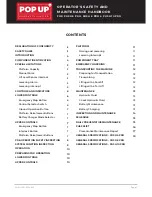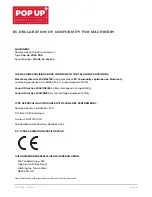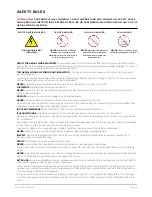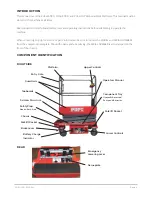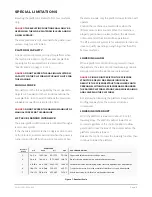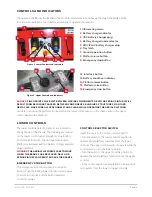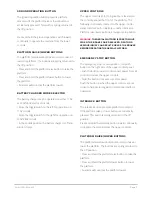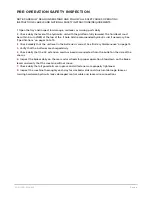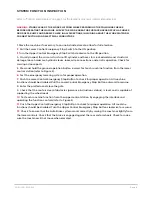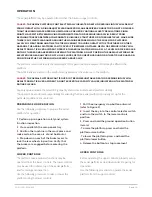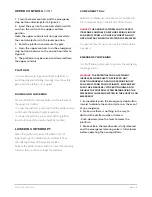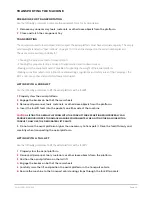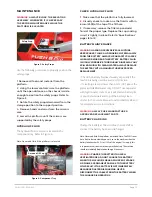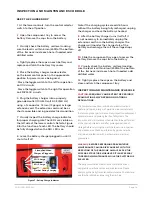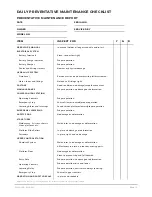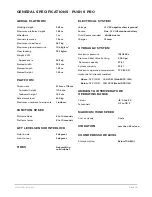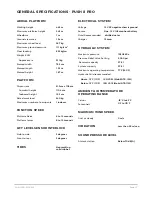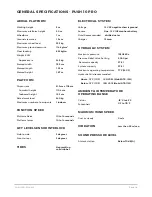
Page 10
PUSH PRO -0120843
OPERATION
The aerial platform may be operated from either the lower or upper controls.
DANGER:
THE AERIAL PLATFORM IS NOT ELECTRICALLY INSULATED. DEATH OR SERIOUS INJURY WILL RESULT
FROM CONTACT WITH, OR INADEQUATE CLEARANCE FROM, AN ENERGIZED CONDUCTOR. DO NOT GO CLOSER
THAN THE MINIMUM SAFE APPROACH DISTANCE AS DE NED BY NATIONAL SAFETY REGULATIONS. PINCH
POINTS MAY EXIST BETWEEN MOVING COMPONENTS. DEATH OR SERIOUS INJURY WILL RESULT FROM
BECOMING TRAPPED BETWEEN COMPONENTS, BUILDINGS, STRUCTURES, OR OTHER OBSTACLES. MAKE SURE
THERE IS SUF CIENT CLEARANCE AROUND THE MACHINE BEFORE MOVING THE CHASSIS OR PLATFORM.
ALLOW SUF CIENT ROOM AND TIME TO STOP MOVEMENT TO AVOID CONTACT WITH STRUCTURES OR OTHER
HAZARDS. THE AERIAL PLATFORM CAN TIP OVER IF IT BECOMES UNSTABLE. DEATH OR SERIOUS INJURY WILL
RESULT FROM A TIP-OVER ACCIDENT. OPERATE THE AERIAL PLATFORM ON A RM, AT, LEVEL SURFACE. ENGAGE
BOTH OF THE REAR BRAKES BEFOR ENTERING THE PLATFORM. DO NOT POSITION THE AERIAL PLATFORM FOR
ELEVATED USE NEAR ANY DROP- OFF, HOLE, SLOPE, SOFT OR UNEVEN GROUND, OR OTHER TIP-OVER HAZARD.
DO NOT RAISE THE PLATFORM IN WIND SPEEDS ABOVE 0 M/S.
The platform rated work load is the total weight of the personnel and equipment that may be lifted in the
platform.
The work loads are stated on the platform rating placard at the entrance to the platform.
DANGER:
THE AERIAL PLATFORM CAN TIP OVER IF IT BECOMES UNSTABLE. DEATH OR SERIOUS INJURY WILL
RESULT FROM A TIP-OVER ACCIDENT. DO NOT EXCEED THE CAPACITY VALUES INDICATED ON THE PLATFORM
RATING PLACARD.
Capacity values indicate the rated lifting capacity and do not indicate aerial platform stability.
The operator bears ultimate responsibility for ensuring that the aerial platform is properly set up for the
particular conditions encountered.
PREPARING FOR OPERATION
Use the following procedure to prepare the aerial
platform for operation:
1
Perform a pre-operation safety and system
function inspection.
2
Close and latch the component tray.
3
Position the machine in the work place and
make certain the area is at and horizontal.
4
Step down on each of the brake levers to
lock the rear wheels in position. Verify that
the brakes are engaged before entering the
platform.
LOWER CONTROLS
The platform raise and lower functions may be
operated from the lower controls. The lower controls
may be used for initial set up of the aerial platform,
and for testing and inspection.
Use the following procedure to raise or lower the
platform using the lower controls.
UPPER CONTROLS
Before operating the upper controls, properly set up
the aerial platform as described under Preparing for
Operation.
Use the following procedure to operate the aerial
platform from the upper controls:
1
Pull the emergency stop button outward
(refer to Figure 2).
2
Insert the key into the control selector switch
and turn the switch to the lower controls
position.
3
Press and hold the ground operation button
inward.
• To raise the platform, press and hold the
platform raise button.
• To lower the platform, press and hold the
platform lower button.
4
Release the button to stop movement.


